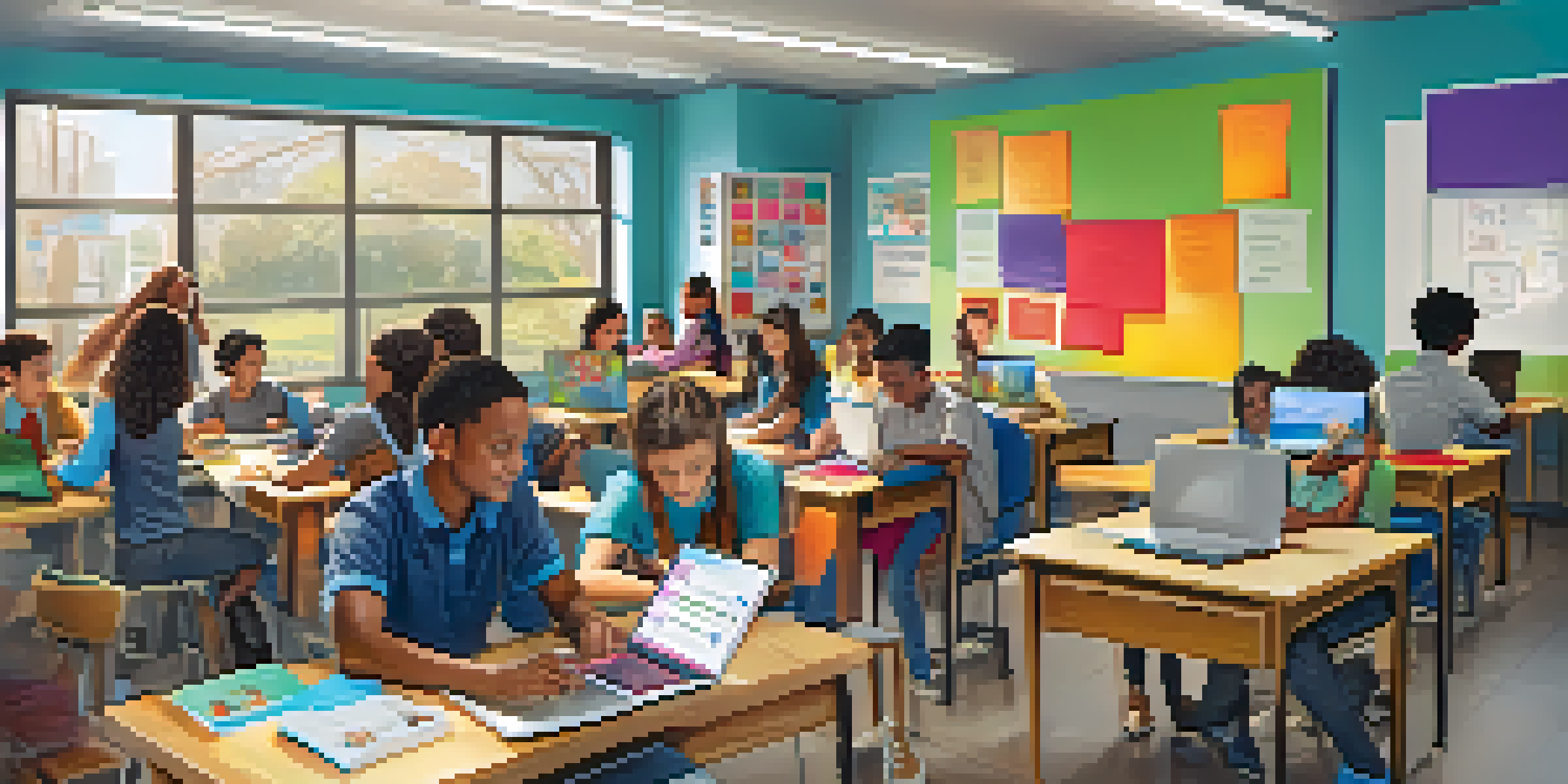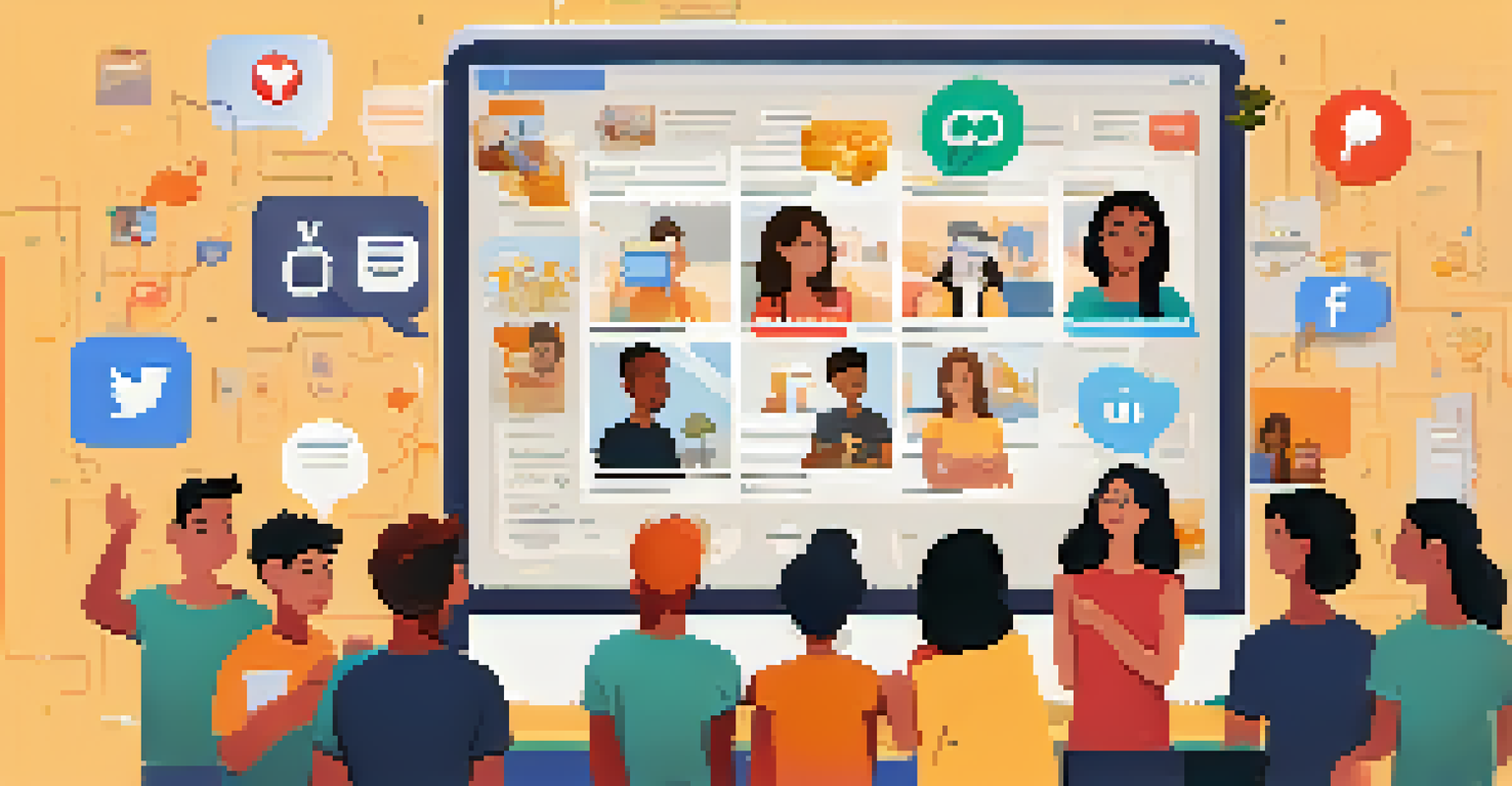Integrating Social Media into Digital Learning Strategies

Understanding the Role of Social Media in Education
Social media has revolutionized the way we communicate and learn. Platforms like Twitter, Facebook, and Instagram allow educators and students to connect in real-time, fostering a sense of community in digital learning environments. This connectivity can enhance collaboration and knowledge sharing, making learning more interactive and engaging.
Social media is not just a tool; it is a platform for collaboration and community building among learners.
By incorporating social media into educational practices, teachers can create a more dynamic learning experience. For instance, students can join discussion groups on Facebook or engage in live Q&A sessions on Twitter. These platforms provide a space for students to express their thoughts and ask questions, promoting a culture of inquiry and support.
Moreover, social media can help break down geographical barriers, allowing learners from different backgrounds and locations to share their perspectives. This diversity enriches discussions and exposes students to a wider range of ideas, ultimately enhancing their educational experience.
Choosing the Right Social Media Platforms for Learning
Not all social media platforms serve the same purpose in education. It's crucial to assess which platforms align best with your learning objectives. For example, LinkedIn is ideal for professional networking and sharing industry insights, while Instagram can be effective for visual storytelling and creative projects.

When selecting a platform, consider your audience's preferences and the type of content you want to share. If you're targeting younger students, platforms like TikTok or Snapchat might resonate better due to their engaging and visual nature. Conversely, older students may prefer platforms that facilitate more in-depth discussions, like Reddit or professional forums.
Social Media Enhances Learning
Platforms like Twitter and Facebook foster real-time communication and collaboration among educators and students, creating a more engaging learning environment.
Ultimately, the goal is to choose platforms that enhance learning outcomes while also being accessible and user-friendly. Mixing various platforms can also be beneficial, as this allows for a richer learning environment that caters to different learning styles.
Creating Engaging Content for Social Media Learning
Content is king, even in the realm of social media. To keep students engaged, it's essential to create content that is not only informative but also entertaining. Utilizing multimedia such as videos, infographics, and live streams can make learning more appealing and capture students' attention effectively.
The greatest danger in times of turbulence is not the turbulence; it is to act with yesterday's logic.
Incorporating interactive elements, like polls or quizzes, can further enhance engagement. For instance, a teacher could host a weekly quiz on Instagram Stories, allowing students to test their knowledge in a fun and interactive way. This not only reinforces learning but also encourages participation.
Remember, the key to effective content is relatability. Using real-life examples, anecdotes, and storytelling can help students connect with the material on a personal level. When learners see the relevance of what they're studying, they're more likely to engage and retain the information.
Fostering Collaboration through Social Media Tools
Collaboration is a cornerstone of effective learning, and social media tools can facilitate this in exciting ways. Platforms like Google Classroom or Slack integrate social media elements to promote teamwork among students. These tools allow for seamless communication and resource sharing, which is vital in a learning environment.
Group projects can be enhanced by using social media for brainstorming and feedback. For example, students can create a private Facebook group to share ideas and resources, enabling them to collaborate more efficiently. This not only encourages teamwork but also helps students develop essential communication skills.
Select Platforms Wisely
Choosing the right social media platforms is crucial for meeting educational goals and catering to the preferences of different student demographics.
Additionally, fostering a collaborative spirit can motivate students to take ownership of their learning. When they work together and support one another, they're more likely to engage deeply with the content and feel a sense of accountability for their peers’ success.
Building a Supportive Online Community for Learners
Creating a supportive online community can significantly enhance the learning experience. Social media platforms provide an excellent avenue for students to connect with their peers, share experiences, and offer encouragement. This sense of belonging can boost motivation and lead to better learning outcomes.
Educators can play a crucial role in fostering this community by initiating discussions and encouraging students to share their thoughts and challenges. Regularly checking in and facilitating conversations can help create a safe space where students feel comfortable expressing themselves.
Moreover, recognizing and celebrating student achievements on social media can further strengthen this community bond. Highlighting accomplishments, whether big or small, fosters a positive atmosphere that encourages continuous engagement and learning.
Addressing Challenges of Social Media in Education
While social media offers numerous benefits for digital learning, it also presents challenges that educators must navigate. Issues such as cyberbullying, misinformation, and distractions can hinder the learning experience. It's essential to address these challenges proactively to ensure a safe learning environment.
Educators should establish clear guidelines and expectations for social media use in their classrooms. This includes discussing appropriate behavior online, encouraging respectful interactions, and emphasizing the importance of verifying information before sharing. Teaching students about digital citizenship can empower them to navigate social media responsibly.
Build a Supportive Community
Creating a positive online community helps students connect, share experiences, and motivates them to engage more deeply with their learning.
Furthermore, creating a balance between social media use and traditional learning methods is vital. While social media can enhance engagement, it's important not to rely solely on it. A blended approach that includes various teaching methods can help mitigate potential distractions and reinforce learning.
Evaluating the Impact of Social Media on Learning Outcomes
To ensure that social media integration is effective, it's important to evaluate its impact on learning outcomes. Educators can use various assessment methods, such as surveys, quizzes, and discussions, to gauge student engagement and understanding. This feedback can provide valuable insights into what works and what needs improvement.
Setting clear objectives for social media use in the classroom can also help measure success. For example, if the goal is to enhance collaboration, educators can track group project outcomes and student participation in discussions. This data can inform future strategies and adjustments to social media integration.

Ultimately, continuous evaluation fosters a culture of improvement. By regularly assessing the effectiveness of social media in enhancing learning, educators can adapt their strategies to better meet the needs of their students, ensuring a more engaging and effective educational experience.